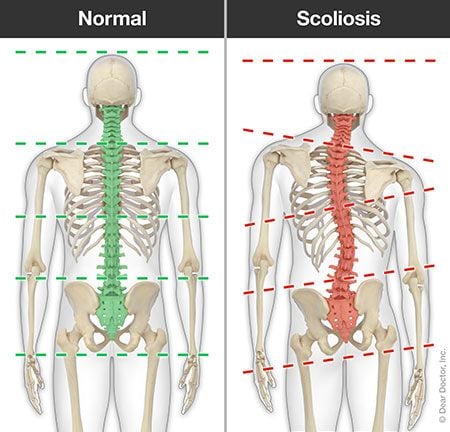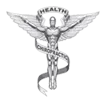Scoliosis is an abnormal sideways curvature of the spine, resulting in a shape like an “S” or “C.” Most people with scoliosis develop it when they are going through a growth spurt during their childhood or teens, and girls are more likely to have it than boys.
It is sometimes caused by certain neurological, muscular or connective tissue disorders. However, most of the time we don’t know what causes the spine to curve, though it does tend to run in families. While many people are not bothered by scoliosis, in some cases it can lead to ongoing pain and fatigue, especially as we age.
Symptoms of Scoliosis

Adults with scoliosis may carry one shoulder or hip higher than the other or have one shoulder blade that seems to stick out more. The curve in the spine will show clearly on an X-ray or other imaging study. Often the curve is mild, but if it is severe or worsens over time, the spine can also twist. Scoliosis is considered mild if the curvature is less than 25 degrees. Moderate scoliosis is a curve between 25 and 50 degrees, and over 50 degrees is considered severe. The greater the curve, the more likely it is that you will have the following symptoms:
- Low back pain
- Stiffness and limited motion
- Pain or numbness from pinched nerves
- Fatigue from uneven weight distribution in the lower back and legs
People with scoliosis often develop more symptoms as they age because of degeneration of the spine, which worsens the curve. Stenosis, or narrowing of the spinal canal, may also develop and increase pain and pressure. If the curve is in your mid back and is severe, no matter your age, it can deform the rib cage. This can affect lung function, limiting the ability to breathe deeply.
People with scoliosis may begin to lean forward, because a bent-over posture opens up space for nerves in the spinal column, relieving pressure and pain. In addition, scoliosis can reduce the natural outward curve of the lower back, which can also make you lean forward. People with scoliosis may compensate by bending their hips and knees in an effort to stand straighter.
Treatment Options for Scoliosis
Even in moderate cases of scoliosis, wear and tear on the spine tends to happen more quickly in comparison to a normal curvature. Being proactive with your abnormal curvature before there is pain will give you the best outcome. In young people, if the curve is becoming more pronounced or it is causing discomfort, your chiropractor may recommend wearing a special brace to keep the spine as straight as possible until it is fully grown.
Spinal fusion surgery may be recommended in severe cases, usually if curves progress beyond 45 degrees in patients who are not fully grown and above 50 degrees in grownups. In this procedure, metal implants are attached to rods that straighten the vertebrae. Eventually, the spinal joints fuse together. Though this may result in a straighter back, it is common to experience limited flexibility and wear and tear above and below the fused segments. Your chiropractor will measure your curves to determine if a surgical consultation is necessary.
There is a natural way to help treat the pain associated with scoliosis without pain medication or spinal fusion. Chiropractic care cannot cure an abnormally curved spine, but it can keep you more mobile and reduce pain and fatigue. Spinal adjustments and muscle work can help you stand straighter, lessening the strain on your back and legs.
In a study of 28 patients in Michigan (National Institutes of Health, U.S. Library of Medicine), those who received chiropractic care for scoliosis reported improvements in pain and disability following treatment. Twenty-two of them had a reduced “Cobb angle” (which measures the curvature) after treatment, and patients also showed improved lung function. The improvement remained two years later.
Periodic visits to the chiropractor as recommended by your practitioner are a safe, non-invasive way to minimize the effects of scoliosis on your daily routine. Adjustments will help keep your joints moving. Addressing spinal misalignments can reduce inflammation and improve overall function. Increased mobility and spinal health will help your body manage the stress of an abnormal spinal curvature and lessen the impact of scoliosis over time.
